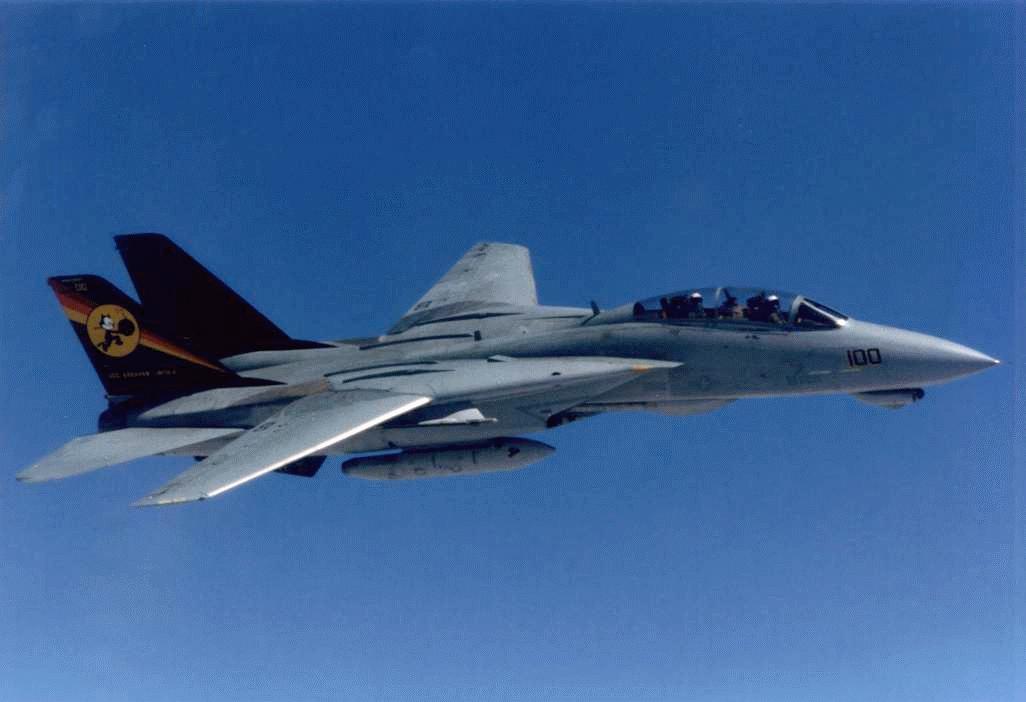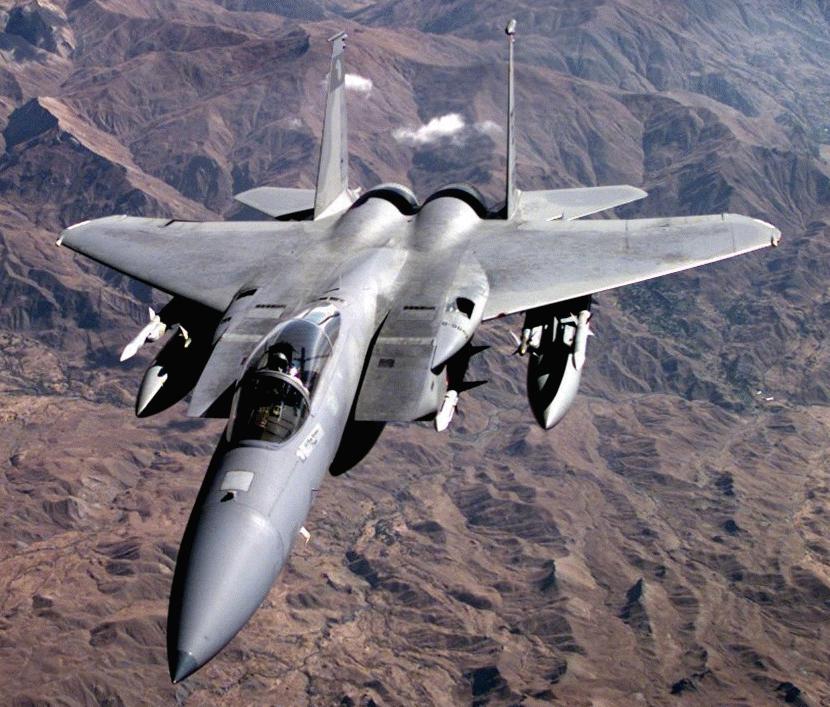|
|
IF F14 TOMCAT MEETS F15 EAGLE IN A DOG FIGHT, WHICH BIRD WILL THRIUMP OVER THE SKY?

| Function | Carrier-based multi-role strike fighter
| | Contractor | Grumman Aerospace Corporation
| | Unit Cost | $38 million
| | Propulsion | F-14: two Pratt & Whitney TF-30P-414A
turbofan engines with afterburners; F-14B and F-14D: two General Electric F-110-GE-400
augmented turbofan engines with afterburners
| | Thrust | F-14A: 20,900 pounds (9,405 kg) static thrust per engine;
F-14B and F-14D: 27,000 pounds (12,150 kg) per engine | | Length | 61 feet 9 inches (18.6 meters)
| | Height | 16 feet (4.8 meters)
| | Maximum Takeoff Weight | 72,900 pounds (32,805 kg)
| | Wingspan | 64 feet (19 meters) unswept, 38 feet (11.4 meters) swept
| | Ceiling | Above 53,000 feet
| | Speed | Max Mach Number = 1.88
Cruise Mach Number = .72
Carrier Approach Speed = 125 kts | | Mission Radius | 500 nm Hi-Med-Hi strike profile
380 nm Hi-Lo-Lo-Hi strike profile | | Crew | Two: pilot and radar intercept officer
| | Armament | Up to 13,000 pounds of Air-to-Air Missiles (up to)
6 AIM-7 Sparrows
4 AIM-9 Sidewinder
6 AIM-54 Phoenix
air-to-ground ordnance
MK-82 (500 lbs.)
4 MK-83 (1,000 lbs.)
4 MK-84 (2,000 lbs.)
MK-20 cluster bomb
4 GBU-10 LGB
GBU-12 MK-82 LGB
4 GBU-16 MK-83 LGB
4 GBU-24 MK-84 LGB
one MK-61A1 Vulcan 20mm cannon
Selected F-14A and B are wired to carry TARPS
All F-14D's are wired to carry the TARPS
| | Countermeasures[/td] | AN/ALR-45 radar warning receiver [Itek] AN/ALR-67 radar warning receiver [F-14D] AN/ALQ-167 ECM Pod [F-14D] AN/ALE-50 towed decoy [F-14D] | | Date Deployed[/td] | | | First flight[/td] | December 1970 | | Inventory[/td] | 157 F-14A/B
53 F-14D
Phasing out one squadron / year
All to be withdrawn by 2010 F-14 orginally designed for 6,000 flight hours
Currently certified for 7,350 flight hours
Potential for extension to 8,000 or 9,000 flight hours
|
[ Last edited by SONofODIN at 24-4-2007 09:25 AM ] |
|
|
|
|
|
|
|
|
|
|
|

| Primary Function | Tactical fighter. | | Contractor | McDonnell Douglas Corp. | | Power Plant | Two Pratt & Whitney F100-PW-100 turbofan engines with afterburners. | | Thrust | (C/D models) 25,000 pounds each engine ( 11,250 kilograms). | | Length | 63 feet, 9 inches (19.43 meters). | | Height | 18 feet, 8 inches (5.69 meters). | | Wingspan | 42 feet, 10 inches (13.06 meters) | | Speed | 1,875 mph (Mach 2.5-plus) at 45,000 ft. | | Ceiling | 65,000 feet (19,697 meters). | | Maximum Takeoff Weight | (C/D models) 68,000 pounds (30,600 kilograms). | | Range | 3,450 miles (3,000 nautical miles) ferry range with conformal fuel tanks and three external fuel tanks. | | Armament | 1 - M-61A1 20mm multibarrel internal gun, 940 rounds of ammunition
4 - AIM-9L/M Sidewinder and
4 - AIM-7F/M Sparrow missiles, or
combination of AIM-9L/M, AIM-7-F/M and AIM-120 missiles. |
| Systems | AN/APG-63 X-band pulsed-Doppler radar [Hughes] AN/APG-70 X-band pulsed-Doppler radar [Hughes]
[ on F-15E, F-15C/D, F-15A/B MSIP] AN/APX-76 IFF interrogator [Hazeltine] AN/ALQ-135(V) internal countermeasures system AN/ALQ-128 radar warning [Magnavox] suite AN/ALR-56 radar warning receiver (RWR) [Loral] AN/ALE-45 chaff/flare dispensers [Tracor] AN/AVQ-26 Pave Tack AN/AXQ-14 Data Link System LANTIRN | | Crew | F-15A/C: one. F-15B/D: two. | Unit cost $FY98
[Total Program] | $43 million. | | Date Deployed | July 1972 | Production
[for USAF] | 360 F-15A/B
408 F-15C
61 F-15D
203 F-15E | | Total Inventory | 275 F-15A/B
410 F-15C/D
203 F-15E Approximately 100 F-15s are in storage @ AMARC | PMAI
Primary Mission Aircraft Inventory | 45 F-15A/B Air National Guard Air Defense Force
45 F-15A/B Air National Guard
126 F-15C/D Air Combat Command
90 F-15C/D Pacific Air Forces
36 F-15C/D US Air Forces Europe
342 F-15A/C TOTAL 66 F-15E Air Combat Command
18 F-15E Pacific Air Forces
48 F-15E US Air Forces Europe
132 F-15E TOTAL |
|
|
|
|
|
|
|
|
|
|
|
|
|
I think the max speed for F14 is more than mach 1.88. Something wrong with the stats. |
|
|
|
|
|
|
|
|
|
|
|
Originally posted by Debmey at 24-4-2007 11:14 AM
I think the max speed for F14 is more than mach 1.88. Something wrong with the stats.
Oh.. yeah. If not mistaken it was supposed to be Mach2.34. Could it be they have reduced the max. speed on the newer model?
F14 was first designed as an interceptor. But the current one it has been redesigned into a multi role fighter. |
|
|
|
|
|
|
|
|
|
|
|
|
Well, it's no longer 'current' as all Tomcats (less the IRIAF's of course) have been retired. |
|
|
|
|
|
|
|
|
|
|
|
|
F-15 is much lighter, has bigger wing area and more powerful engines. So it would be better in dogfight. |
|
|
|
|
|
|
|
|
|
mat_toro This user has been deleted
|
Reply #6 Nick_Perelman's post
|
But bigger wing area means more drag... less maneuverability... kinda like the delta wings... but very high speed and rate of climb... delta wing structure also allows for greater tolerance to fatigue from high speeds... dunno which design is best for what though... |
|
|
|
|
|
|
|
|
|
|
|
Petikan Ini pasal F-14 "This favorite plane of many is being retired after 33 years of service because the cost/time of maintenance is four times higher than the F-18 Hornet's. F-18(...) the Hornet is not an excellent plane, it is just good, it does the job, and for the way combat happens nowadays, you don't need more...but for flying, I'd rather get in the Tomcat and hit the afterburners!!!
Pablo A Romay 07/06 |
|
|
|
|
|
|
|
|
|
|
|
|
Imagine what it would cost the iranians to keep it flying. and they can't even shoot those phoenix AA missiles. shld have dumped it long ago and use teh money to buy Su30. |
|
|
|
|
|
|
|
|
|
|
|
Reply #9 Debmey's post
|
The Tomcats won all the dogfights with Iraq until the birds ran out of spare parts. I don't think the Irianian were supplied with the Phoenix. ??? |
|
|
|
|
|
|
|
|
|
|
|
Originally posted by mat_toro at 25-4-2007 11:12 AM
But bigger wing area means more drag... less maneuverability... kinda like the delta wings... but very high speed and rate of climb... delta wing structure also allows for greater tolerance to fa ...
No its more horizontal maneuverability (vertical depends mainly of power/weight ratio). No wonder that F-104 was known as flying coffin. In dog fights F-15 was always better. Today when F-15 are armed with AIM-9X Iranian F-14 have no chance at all. |
|
|
|
|
|
|
|
|
|
|
|
Originally posted by Nick_Perelman at 25-4-2007 06:28 PM
No its more horizontal maneuverability (vertical depends mainly of power/weight ratio). No wonder that F-104 was known as flying coffin. In dog fights F-15 was always better. Today when F-15 ar ...
Iranian's F14 are all in the scrap yard now. |
|
|
|
|
|
|
|
|
|
|
|
unless the tomcats flown by jedi pilots hehe
may the farce be with us. |
|
|
|
|
|
|
|
|
|
|
|
Reply #10 SONofODIN's post
|
They did although it was said that they were sabotaged during the Revolution. |
|
|
|
|
|
|
|
|
|
|
|
Reply #12 SONofODIN's post
|
Some are still flying, making them the last Tomcat operator. |
|
|
|
|
|
|
|
|
|
mat_toro This user has been deleted
|
Reply #11 Nick_Perelman's post
|
True... its not necessarily who has the better plane... nowadays its usually who has the better missile... |
|
|
|
|
|
|
|
|
|
|
|
Reply #16 mat_toro's post
Not unless it's the F-22.
You could win a fight with just aim 9x with that.
And also important is the type of radar and EW and ECM systems on board.
Alot of factors actually. |
|
|
|
|
|
|
|
|
|
|
|
Reply #1 SONofODIN's post
Platform vs Platform comparisons are meaningless in combat. Wars are not won on the basis of weapon 'X' vs Weapon 'Y'. It is the side which has the best military 'system' which will win.
Weapons ARE important. Training is EVEN MORE important. Logistics is EVERYTHING. |
|
|
|
|
|
|
|
|
|
|
|
Reply #19 wei_loon5063's post
still the best...vf-1 valkyrie.

VF-1D two-place combat-capable trainer at South Ataria Island, 7 February 2009. Behind it is the single-seat air superiority variant, VF-1A. |
|
|
|
|
|
|
|
|
|
| |
|